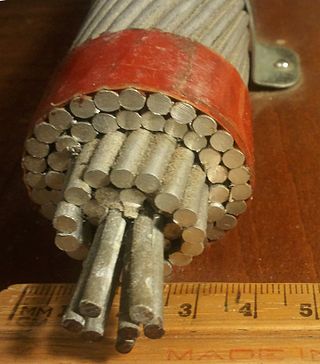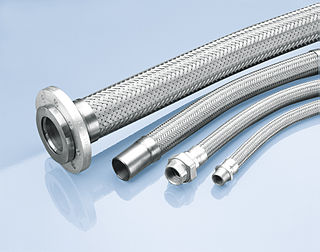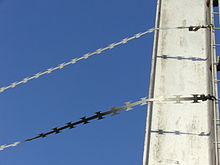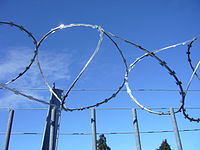
A wire is a flexible, round, bar of metal.

A fence is a structure that encloses an area, typically outdoors, and is usually constructed from posts that are connected by boards, wire, rails or netting. A fence differs from a wall in not having a solid foundation along its whole length.

Barbed wire, also known as barb wire, is a type of steel fencing wire constructed with sharp edges or points arranged at intervals along the strands. Its primary use is the construction of inexpensive fences, and it is also used as a security measure atop walls surrounding property. As a wire obstacle, it is a major feature of the fortifications in trench warfare.

In agriculture, fences are used to keep animals in or out of an area. They can be made from a wide variety of materials, depending on terrain, location and animals to be confined. Most agricultural fencing averages about 4 feet (1.2 m) high, and in some places, the height and construction of fences designed to hold livestock is mandated by law.

Concertina wire or Dannert wire is a type of barbed wire or razor wire that is formed in large coils which can be expanded like a concertina. In conjunction with plain barbed wire and steel pickets, it is most often used to form military-style wire obstacles. It is also used in non-military settings, such as when used in prison barriers, detention camps, riot control, or at international borders. During World War I, soldiers manufactured concertina wire themselves, using ordinary barbed wire. Today, it is factory made.

In the military science of fortification, wire obstacles are defensive obstacles made from barbed wire, barbed tape or concertina wire. They are designed to disrupt, delay and generally slow down an attacking enemy. During the time that the attackers are slowed by the wire obstacle they are easy to target with machine gun and artillery fire. Depending on the requirements and available resources, wire obstacles may range from a simple barbed wire fence in front of a defensive position, to elaborate patterns of fences, concertinas, "dragon's teeth" and minefields hundreds of metres thick.

Joseph Farwell Glidden was an American businessman and farmer. He was the inventor of the modern barbed wire. In 1898, he donated land for the Northern Illinois State Normal School in DeKalb, Illinois, which was renamed as Northern Illinois University in 1957.

A fastener or fastening is a hardware device that mechanically joins or affixes two or more objects together. In general, fasteners are used to create non-permanent joints; that is, joints that can be removed or dismantled without damaging the joining components. Steel fasteners are usually made of stainless steel, carbon steel, or alloy steel.
A wire is a strand of drawn metal used especially in electrical conductors and fencing.

An electric fence is a barrier that uses electric shocks to deter people and/or other animals from crossing a boundary. The voltage of the shock may have effects ranging from discomfort to death. Most electric fences are used for agricultural fencing and other forms of non-human animal control, although they are also used to protect high-security areas such as military installations or prisons, where potentially-lethal voltages may be used. Virtual electric fences for livestock using GPS technology have also been developed.

A chain-link fence is a type of woven fence usually made from galvanized or linear low-density polyethylene-coated steel wire. The wires run vertically and are bent into a zigzag pattern so that each "zig" hooks with the wire immediately on one side and each "zag" with the wire immediately on the other. This forms the characteristic diamond pattern seen in this type of fence.

Isaac Leonard Ellwood was an American rancher, businessman and barbed wire entrepreneur.

Jacob Haish was one of the first inventors of barbed wire. His type of barbed wire was in direct competition with the other barbed wire manufacturers in DeKalb, Illinois. He was a known carpenter and architect in DeKalb County and designed several prominent DeKalb homes.

Temporary fencing is a free standing, self-supporting fence panel. The panels are held together with couplers that interlock panels together making it portable and flexible for a wide range of applications. A common type of temporary fencing is Heras fencing.

The Joseph F. Glidden House is located in the United States in the DeKalb County, Illinois city of DeKalb. It was the home to the famed inventor of barbed wire Joseph Glidden. The barn, still located on the property near several commercial buildings, is said to be where Glidden perfected his improved version of barbed wire which would eventually transform him into a successful entrepreneur. The Glidden House was added to the National Register of Historic Places in 1973. The home was designed by another barbed wire patent holder in DeKalb, Jacob Haish.

A pest-exclusion fence is a barrier that is built to exclude certain types of animal pests from an enclosure. This may be to protect plants in horticulture, preserve grassland for grazing animals, separate species carrying diseases from livestock, prevent troublesome species entering roadways, or to protect endemic species in nature reserves. These fences are not necessarily traditional wire barriers, but may also include barriers of sound, or smell.

Welded wire mesh, or welded wire fabric, or "weldmesh" is an electric fusion welded prefabricated joined grid consisting of a series of parallel longitudinal wires with accurate spacing welded to cross wires at the required spacing.
Weldedwire mesh fence is a steel fence consisting of wire strands electrically welded together to form a high strength mesh. The fencing is available in two formats: rolled mesh and rigid mesh. Over the last 30 years rigid mesh fencing has become the system of choice for demarcation across the UK, Europe and Australia.

A metal hose is a flexible metal line element. There are two basic types of metal hose that differ in their design and application: stripwound hoses and corrugated hoses.
Perimeter security refers to natural barriers or built fortifications to either keep intruders out or to keep captives contained within the area the boundary surrounds.





















